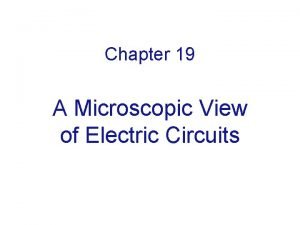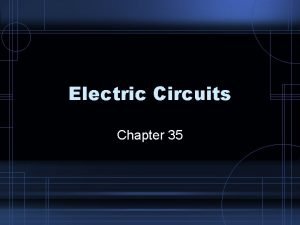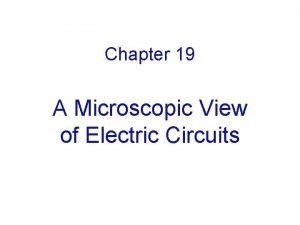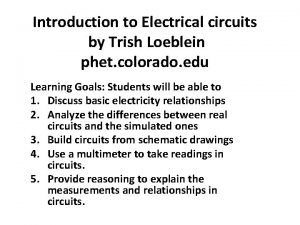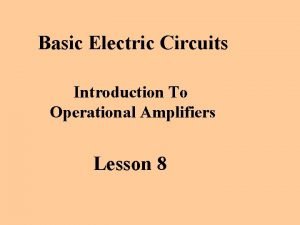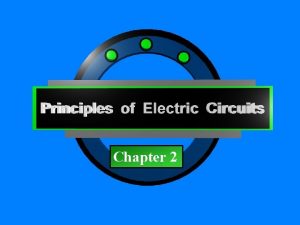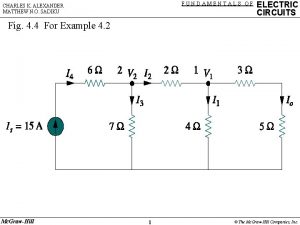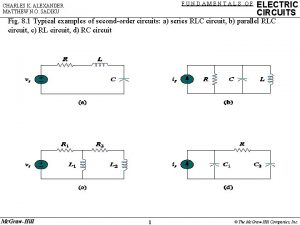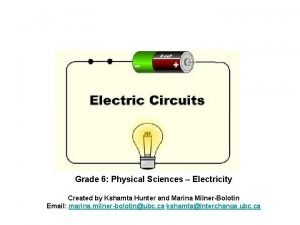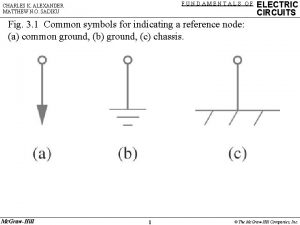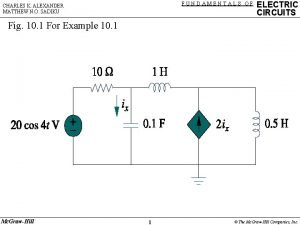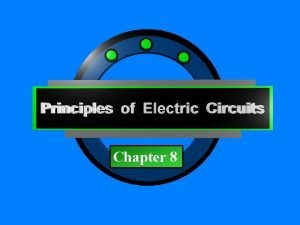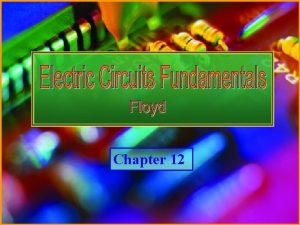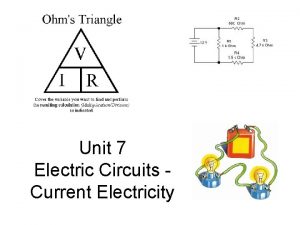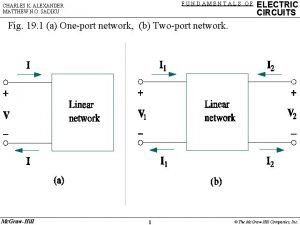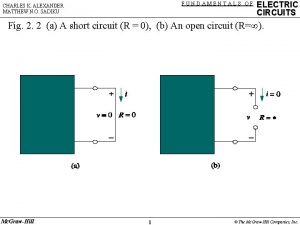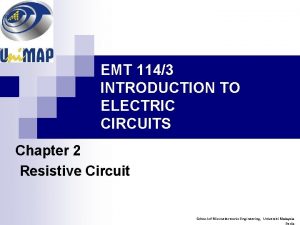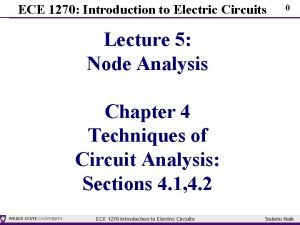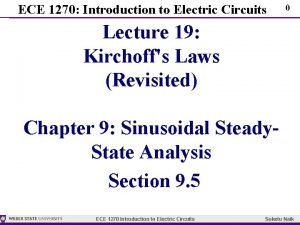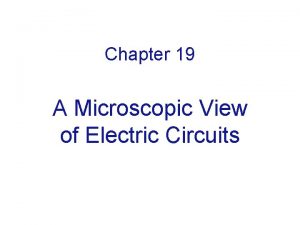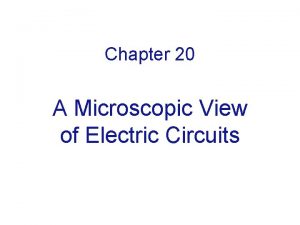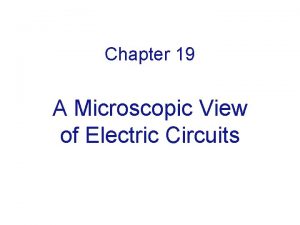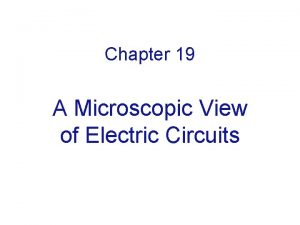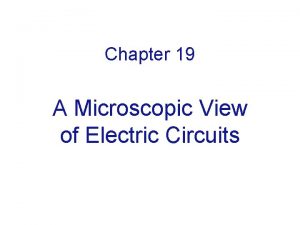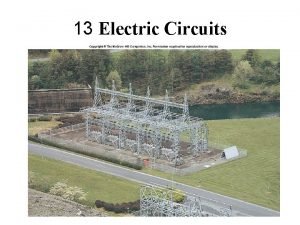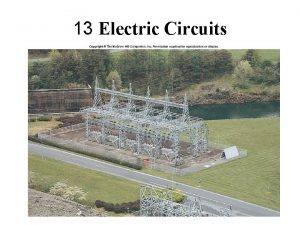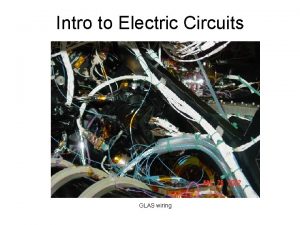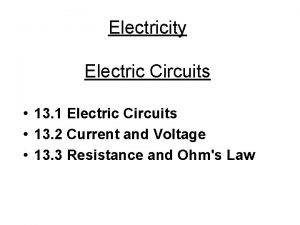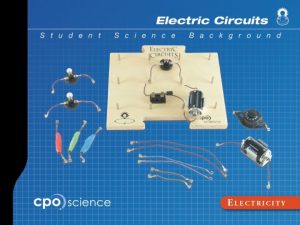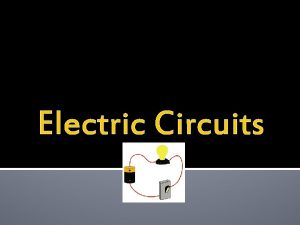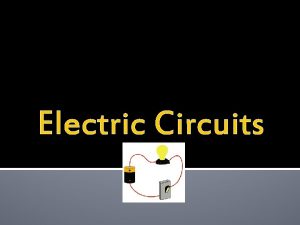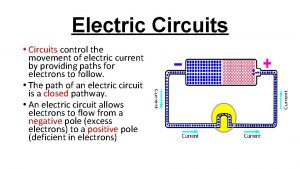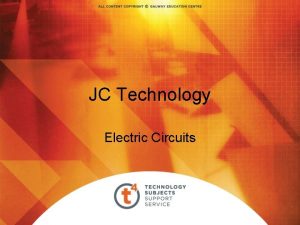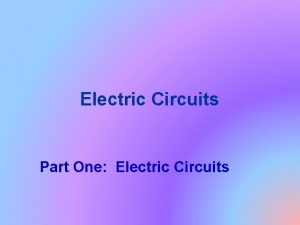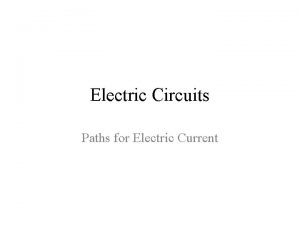Chapter 19 A Microscopic View of Electric Circuits











































- Slides: 43

Chapter 19 A Microscopic View of Electric Circuits

Current in a Circuit A microscopic view of electric circuits: • Are charges used up in a circuit? • How is it possible to create and maintain a nonzero electric field inside a wire? • What is the role of the battery in a circuit? In an electric circuit the system does not reach equilibrium! Steady state and static equilibrium Static equilibrium: • no charges are moving Steady state (Dynamic Equilibrium): • charges are moving • their velocities at any location do not change with time • no change in the deposits of excess charge anywhere

Current in Different Parts of a Circuit IB = IA in a steady state circuit We cannot get something for nothing! What is used up in the light bulb? Energy is transformed from one form to another Electric field – accelerates electron Friction – energy is lost to heat Battery – chemical energy is used up Closed circuit – energy losses to heat: not an isolated system!

Current at a Node The current node rule (Kirchhoff node or junction rule [law #1]): i 1 = i 2 = i 3 + i 4 In the steady state, the electron current entering a node in a circuit is equal to the electron current leaving that node (consequence of conservation of charge) Gustav Robert Kirchhoff (1824 - 1887)

Exercise Write the node equation for this circuit. What is the value of I 2? I 1 + I 4 = I 2 + I 3 I 2 = I 1 + I 4 - I 3 = 3 A What is the value of I 2 if I 4 is 1 A? I 1 + I 4 = I 2 + I 3 I 2 = I 1 + I 4 - I 3 = -2 A 1 A Charge conservation: Ii > 0 for incoming Ii < 0 for outgoing

Motion of Electrons in a Wire In a current-carrying wire, the electric field drives the mobile charges. What is the relationship between the electric field and the current? Why is an electric field required? Electrons lose energy to the lattice of atomic cores. Electric field must be present to increase the momentum of the mobile electrons. Collisions with Core gives frictional force. In steady state, net force is zero.

The Drude Model E Momentum principle: Speed of the electron: Average ‘drift’ speed: - average time between collisions

The Drude Model Average ‘drift’ speed: - average time between collisions For constant temperature u – mobility of an electron Electron current: Paul Drude (1863 - 1906)

E and Drift Speed In steady state current is the same everywhere in a series circuit. i Ethin Ethick i What is the drift speed? Note: density of electrons n cannot change if same metal What is E?

Exercise 0. 1 mm vthin = ? vthick = 4 10 -5 m/s Ethin= 10 -1 N/C Ethick= ? vthin = 400 10 -5 m/s Ethick= 10 -3 N/C

Question 1. 5. n 1 = n 2 2. u 1 = u 2 1018 1 mm 2 mm Every second 1018 electrons enter the thick wire. How many electrons exit from the thin wire every second? A) B) 1. 5 x 1018 C) 2 x 1018 D) 4 x 1018 E) 12 x 1018

Question 1. 5. n 1 = n 2 2. u 1 = u 2 1018 1 mm 2 mm What is the ratio of the electric field, E 1/E 2? A) B) C) D) 3: 1 6: 1 8: 1 12: 1

Direction of Electric Field in a Wire E must be parallel to the wire E is the same along the wire Does current fill the wire? Is E uniform across the wire? VAB 0 VCD 0

A Mechanical Battery Van de Graaff generator Electron Current

Connecting a Circuit When making the final connection in a circuit, feedback forces a rapid rearrangement of the surface charges leading to the steady state. This period of adjustment before establishing the steady state is called the initial transient. The initial transient

Connecting a Circuit 1. Static equilibrium: nothing moving (no current) 2. Initial transient: short-time process leading to the steady state 3. Steady state: constant current (nonzero)

Current at a Node i 1 = i 2 = i 3 + i 4 The current node rule (Kirchhoff node or junction rule [law #1]): In the steady state, the electron current entering a node in a circuit is equal to the electron current leaving that node

Energy in a Circuit Vwire = EL Vbattery = ? Energy conservation (the Kirchhoff loop rule [2 nd law]): V 1 + V 2 + V 3 + … = 0 along any closed path in a circuit V= U/q energy per unit charge

Potential Difference Across the Battery Coulomb force on each e FC non-Coulomb force on each e EC 1. FC =e. EC 2. FC =FNC Fully charged battery. Energy input per unit charge emf – electromotive force The function of a battery is to produce and maintain a charge separation. The emf is measured in Volts, but it is not a potential difference! The emf is the energy input per unit charge. chemical, nuclear, gravitational…

Field and Current in a Simple Circuit Round-trip potential difference: We will neglect the battery’s internal resistance for the time being.

Field and Current in a Simple Circuit Round-trip potential difference: Path 1 Path 2

V Across Connecting Wires The number or length of the connecting wires has little effect on the amount of current in the circuit. uwires >> ufilament Work done by a battery goes mostly into energy dissipation in the bulb (heat).

Application: Energy Conservation V 1 + V 2 + V 3 + Vbatt = 0 (-E 1 L 1) + (-E 2 L 2) + (-E 3 L 3) + emf = 0 An electron traversing the circuit DC-B-A suffers a decrease in its electric potential energy. Where does this loss of energy appear?



Twice the Length Nichrome wire (resistive) Quantitative measurement of current with a compass Current is halved when increasing the length of the wire by a factor of 2.

Doubling the Cross-Sectional Area Loop: emf - EL = 0 Electron current in the wire increases by a factor of two if the crosssectional area of the wire doubles. Nichrome wire

Two Identical Light Bulbs in Series Two identical light bulbs in series are the same as one light bulb with twice as long a filament. Identical light bulbs Electron mobility in metals decreases as temperature increases! Conversely, electron mobility in metals increases as temperature decreases. Thus, the current in the 2 -bulb circuit is slightly more than that in the one-bulb circuit.

Two Light Bulbs in Parallel L … length of bulb filament 1. Path ABDFA: 2. Path ACDFA: 3. Path ABDCA: F i. B = i C ibatt = 2 i. B We can think of the two bulbs in parallel as equivalent to increasing the cross-sectional area of one of the bulb filaments.

Analysis of Circuits The current node rule (Charge conservation) Kirchhoff node or junction rule [1 st law]: In the steady state, the electron current entering a node in a circuit is equal to the electron current leaving that node Electron current: i = n. Au. E Conventional current: I = |q|n. Au. E The loop rule (Energy conservation) Kirchhoff loop rule [2 nd law]: V 1 + V 2 + V 3 + … = 0 along any closed path in a circuit V= U/q energy per unit charge

Resistance Conventional current: Widely known as Ohm’s law Resistance of a long wire: George Ohm (1789 -1854) Units: Ohm, Resistance combines conductivity and geometry!

Microscopic and Macroscopic View Microscopic Macroscopic Can we write V=IR ? Current flows in response to a V

Constant and Varying Conductivity Mobility of electrons: depends on temperature Conductivity and resistance depend on temperature. Conductivity may also depend on the magnitude of current.

Ohmic Resistors Ohmic resistor: resistor made of ohmic material Ohmic materials: materials in which conductivity is independent of the amount of current flowing through not a function of current Examples of ohmic materials: metal, carbon (at constant T!)

Is a Light Bulb an Ohmic Resistor? Tungsten: mobility at room temperature is larger than at ‘glowing’ temperature (~3000 K) V-A dependence: 3 V 100 m. A 1. 5 V 80 m. A 0. 05 V 6 m. A R 30 19 8 I V

Semiconductors Metals, mobile electrons: slightest V produces current. If electrons were bound – we would need to apply some field to free some of them in order for current to flow. Metals do not behave like this! Semiconductors: n depends exponentially on E Conductivity rises (resistance drops) with rising temperature

Series Resistance Vbatt + V 1 + V 2 + V 3 = 0 emf - R 1 I - R 2 I - R 3 I = 0 emf = R 1 I + R 2 I + R 3 I emf = (R 1 + R 2 + R 3) I emf = Requivalent I , where Requivalent = R 1 + R 2 + R 3

Exercise: Voltage Divider Know R , find V 1, 2 R 1 V 1 R 2 V 2 emf Solution: 1) Find current: 2) Find voltage: 3) Check:

Parallel Resistance I = I 1 + I 2 + I 3

Two Light Bulbs in Parallel What would you expect if one is unscrewed? A) The single bulb is brighter B) No difference C) The single bulb is dimmer

Work and Power in a Circuit Current: charges are moving work is done Work = change in electric potential energy of charges Power = work per unit time: I Power for any kind of circuit component: Units:

Power Dissipated by a Resistor emf R Know V, find P Know I, find P In practice: need to know P to select right size resistor – capable of dissipating thermal energy created by current. What is the power output of the battery?

Question A certain capacitor with only air between its plates has capacitance C and is connected to a battery for a long time until the potential difference across the capacitor is equal to 3 V. The battery is then removed from the circuit and a dielectric (K=2) is inserted between the capacitor plates filling the entire volume. The energy stored in the capacitor WITH dielectric compared to the energy stored Without dielectric is: A) The same B) Larger by a factor of 2 C) Smaller by a factor of 2 D) Larger by a factor of 4 E) Smaller by a factor of 4
 Is a light bulb an ohmic resistor
Is a light bulb an ohmic resistor Fundamentals of electric circuits chapter 4 solutions
Fundamentals of electric circuits chapter 4 solutions Electric current
Electric current Chapter 35 electric circuits
Chapter 35 electric circuits Chapter 20 electric circuits
Chapter 20 electric circuits 9
9 Fundamentals of electric circuits chapter 7 solutions
Fundamentals of electric circuits chapter 7 solutions Chapter 35 electric circuits answers
Chapter 35 electric circuits answers Worksheet circuits and ohm's law answer key
Worksheet circuits and ohm's law answer key Chapter 35 electric circuits
Chapter 35 electric circuits Microscopic view of current
Microscopic view of current Laplace pressure
Laplace pressure Current in a parallel circuit
Current in a parallel circuit Chapter 21 electric charge and electric field
Chapter 21 electric charge and electric field Chapter 21 electric charge and electric field
Chapter 21 electric charge and electric field Chapter 16 electric charge and electric field
Chapter 16 electric charge and electric field Chapter 21 electric charge and electric field
Chapter 21 electric charge and electric field Phet circuit
Phet circuit Electric circuits equations
Electric circuits equations Electric circuits nilsson
Electric circuits nilsson Principles of electric circuits
Principles of electric circuits What three elements are required for all electric circuits
What three elements are required for all electric circuits Fundamentals of electric circuits
Fundamentals of electric circuits Sadiku
Sadiku Elec 202
Elec 202 Kshamta hunter
Kshamta hunter Alexander
Alexander Alexander
Alexander The circuit chapter 8 summary
The circuit chapter 8 summary Electric circuits fundamentals floyd
Electric circuits fundamentals floyd Circuit symbols
Circuit symbols Alexander
Alexander Alexander and sadiku
Alexander and sadiku Introduction to electric circuits
Introduction to electric circuits Introduction to electric circuits
Introduction to electric circuits Introduction to electric circuits
Introduction to electric circuits Quarturs
Quarturs Analogy between electric and magnetic circuits
Analogy between electric and magnetic circuits Electric field formula voltage
Electric field formula voltage Electric potential difference
Electric potential difference Electric potential
Electric potential Electric potential from electric field
Electric potential from electric field A suitable electric pump in an electric circuit is a
A suitable electric pump in an electric circuit is a Electric charges and electric forces lesson outline
Electric charges and electric forces lesson outline
